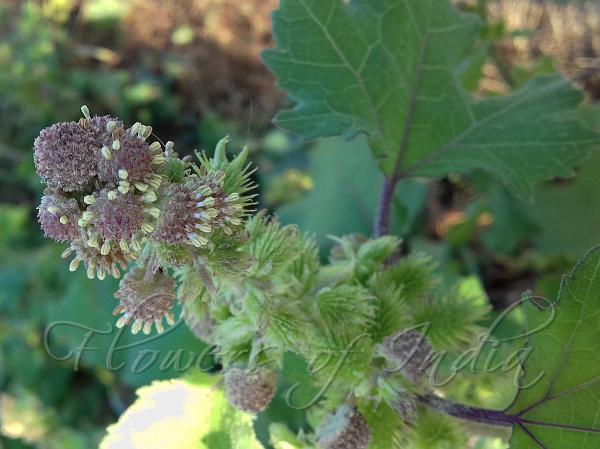|
| Common Cocklebur |
|

|

| File size | 607753 |
| Original date | 10/6/20 7:51 AM |
| Resolution | 3264 x 1836 |
| Flash | Flash did not fire |
| Focal length | 3.3mm |
| Exposure time | 1/133s |
| Aperture | 2.2 |
| Focus Distance | |
| Metering Mode | Spot |
| Camera make | samsung |
| Camera model | SM-J210F |
| Sensor type |
|
|
|
|
Photo: |
Botanical name: Xanthium strumarium Family: Asteraceae (Sunflower family)
Synonyms: Xanthium indicum
Synonyms: Xanthium indicum
All of us have known this plant from our childhood. One can’t miss it when
the seeds are ripe. The fruits are covered with numerous hooks and kids
have fun throwing it at people and sticking it to their woollen clothing.
The plant has large and broad leaves, light and bright green in color in an
alternate pattern with irregular lobes and relatively inconspicuous teeth.
Stems turn maroon to black when mature, with an elliptic or egg shaped
fruit clusters growing nestled around the stem. Common Cocklebur is an annual herb with a
short, stout, hairy stem. Flower heads occur in racemes in leaf axils or at
the end of branches. The flowers are white or green, numerous, male upper
most, female ovoid, covered with hooked bristles. Fruit is obovoid, enclosed
in the hardened involucre, with 2 hooked beaks and hooked bristles.
Common Cocklebur is native to S. Central & S. Europe to China and Indo-China,
Taiwan, NW. Africa. It is also found in West Himalayas.
Flowering: August-September.
Medicinal uses: The whole plant, specially root and fruit, is
used as medicine. According to Ayurveda, X. strumarium is cooling,
laxative, fattening, anthelmintic, alexiteric, tonic, digestive,
antipyretic, and improves appetite, voice, complexion, and memory. It cures
leucoderma, biliousness, poisonous bites of insects, epilepsy, salivation
and fever.
The whole plant, specially root and fruit, is
used as medicine. According to Ayurveda, X. strumarium is cooling,
laxative, fattening, anthelmintic, alexiteric, tonic, digestive,
antipyretic, and improves appetite, voice, complexion, and memory. It cures
leucoderma, biliousness, poisonous bites of insects, epilepsy, salivation
and fever.
Medicinal uses:
 The whole plant, specially root and fruit, is
used as medicine. According to Ayurveda, X. strumarium is cooling,
laxative, fattening, anthelmintic, alexiteric, tonic, digestive,
antipyretic, and improves appetite, voice, complexion, and memory. It cures
leucoderma, biliousness, poisonous bites of insects, epilepsy, salivation
and fever.
The whole plant, specially root and fruit, is
used as medicine. According to Ayurveda, X. strumarium is cooling,
laxative, fattening, anthelmintic, alexiteric, tonic, digestive,
antipyretic, and improves appetite, voice, complexion, and memory. It cures
leucoderma, biliousness, poisonous bites of insects, epilepsy, salivation
and fever. | Identification credit: Eby Abraham, Abhishek Malpotra | Photographed at Hiranagar, Jammu & Thane, Maharashtra. |
• Is this flower misidentified? If yes,